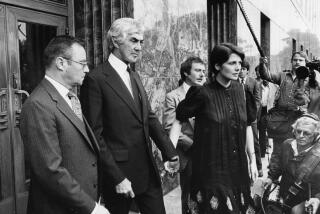Dream of Riches Leads Straight to Courtroom : Lawsuit: Finding ‘abandoned’ artwork for recordings by the Beatles and Jimi Hendrix was like finding buried treasure. Then the trouble started.
Sitting around a table at Denny’s, the five of them held their glasses in a toast to their good fortune.
In a rental truck parked outside the Sunset Boulevard restaurant were nearly 3,000 boxes containing rare photos and artwork that they thought could make them all rich.
Each container--a “flat” about the size of a large pizza box--held the original artwork and design plans from a Capitol Records album, and the four men and one woman had stumbled across them in the dusty basement of a Hollywood theater. Potentially worth millions of dollars to collectors, the materials had been abandoned--or so they thought.
“We raised our little water glasses and toasted,” said David Pro, a former limousine driver from North Hollywood who was one of those around the restaurant table last year.
“It was like ‘The Treasure of the Sierra Madre,’ ” Pro said. “But you know what happened in the movie. . . . Greed happened.”
The artwork came from records that included “Sgt. Pepper’s Lonely Hearts Club Band” and “Abbey Road” by the Beatles. Other boxes in the treasure trove were labeled with the titles of albums by Frank Sinatra, Nat King Cole, Judy Garland, Jimi Hendrix and the Beach Boys.
But the camaraderie of that night soon evaporated as the group broke apart in a dispute over how the treasure would be split.
This week, a massive legal case that involves Capitol Records and the Pantages Theatre, from which the materials were taken, rolled into court.
The case, in Los Angeles Superior Court, involves accusations of fraud and theft, allegations of threats. Private detectives have secretly followed some of the litigants. Longtime friends are distanced by distrust.
Meanwhile, the treasure sits in a storage vault at an undisclosed location, waiting for a jury to decide its rightful owner.
It is a case that in Pro’s words will show how “the prospect of money can change people.” It is a story about how dreams can be shattered--or, at the very least, held up in court for a year.
According to court records, it all began in 1989 when Capitol Records employees somehow overlooked a roomful of the photos, drawings, letters and other items when they vacated a rented storage area below the Pantages.
Capitol had rented space in the cavernous basement of the Hollywood Boulevard theater beginning in 1969 to archive its artwork and recordings. After the company built its own storage facility, the space was emptied. Or so company officials thought.
Although three large rooms were cleared, a fourth room containing the artwork was left untouched and unlocked, according to court records and those familiar with the case.
“They said they were removing their items and ‘Thank you, very much,’ ” said Deborah M. Nesset, an attorney for J. Ned Inc., which owns the theater. “They did not realize they left a roomful of artwork.”
Neither did anyone else, apparently, for the next two years, until the space was rented again, and a theater maintenance crew was asked to clear out the boxes. The boxes, caked with nearly an inch of dust, were moved to an open storage area near the theater’s boiler. The area is known by employees as the dungeon, a dark area where broken theater equipment is stored.
Uncontested in the court case is what happened next. On Jan. 19, 1991, five people with a rented truck took the boxes. They were James Engle, a dispatcher for a limousine service headquartered at the theater; Kimberly Foster, an assistant manager at the theater; Randy Wolf and Pro, former employees of the limousine service, and George Boissonnault, who worked in the theater’s subscription department.
Engle and Foster organized the effort, telling the other three that they had stumbled across the find and that the boxes were to be thrown out.
The moving job took four hours. Several Pantages employees--there was a Saturday matinee of the musical “Les Miserables” scheduled--saw the boxes being taken but were not alarmed. After the work was done, the five movers ate lunch at Denny’s before storing the boxes.
“James and Kim said that they had formed a partnership for the purpose of disposing of the boxes and that we could either take the hourly wage we were promised or we could wait until the boxes were disposed of and then James would ‘make all our dreams come true’ out of his half of the expected proceeds,” Boissonnault said.
“Everyone agreed to wait. . . . At no time did I consider, nor was I led to believe by anyone, that my actions were in any way improper or unlawful.”
Pro also claims in court papers that before taking the boxes, Engle agreed to cut him in on 20% of the proceeds from selling the materials to memorabilia collectors. Engle disputes the claim.
After taking the boxes from the theater, Engle and Foster formed a corporation called Legends by Design. The company’s first sale, for $2,500 to a Burbank auctioneer, was a series of Robin Hood drawings from a Capitol storybook record released in the late 1940s. Next, Disney and Warner Bros. animation artwork from other storybook records were put up for auction at a minimum bid of $16,000. They brought in $23,000.
With the contents of one box sold and thousands of boxes left to go, a celebration was in order, Pro said. He took champagne to Engle’s house the night of the auction. The group decided to contact the prestigious Sotheby’s auction house in New York to auction the artwork for the Capitol rock ‘n’ roll albums.
But the good feelings and dreams of wealth were short-lived. Pro said Engle and Foster began avoiding him and refused to pay him his share of the auction proceeds. They then moved the boxes from the Hollywood storage facility to an unknown location. Pro said he hired a private detective to follow them and to find the boxes, but the effort was unsuccessful.
The dispute brought about the downfall of the whole endeavor. Pro went to an attorney to see what his rights were to the Capitol materials, and the attorney advised him to first check with the Pantages management to make sure that the materials had been taken legitimately.
On April 27, 1991, Pro and his attorney met with Pantages owners and attorneys.
“Their jaws dropped when I told them,” Pro said last week. “They couldn’t believe what had been sitting down there.”
Pantages officials decided to attempt to recover the materials on their own, without help from police. They also hired private detectives to follow Engle and Foster, but they were unable to find the new storage place.
On May 10, 1991, J. Ned Inc. filed a lawsuit against Engle, Foster and Wolfe, who is Engle’s roommate, alleging that the 3,000 boxes were taken illegally. Engle’s brother, Lester Engle, and Foster’s mother, Nancy Sletlin, also were named as defendants because they allegedly helped plan how to sell the materials. Pro and Boissonnault were not sued because Pantages officials believe that they unwittingly helped take the boxes and received no money from the first sales.
“None of the defendants had the authority or permission to remove the property from the Pantages premises,” the suit claims.
The suit denies that the boxes were to be thrown out and claims that if a jury determines that the materials were mistakenly abandoned by Capitol, they belongs to J. Ned Inc., not the defendants.
“The material was not being thrown out. . . . That is ludicrous,” said Nesset, the J. Ned attorney.
The defendants, however, maintain that they did indeed “rescue” the materials from the trash and that J. Ned only became interested after learning of its value from Pro. Engle, a Los Angeles resident, said that before taking the boxes, he checked with Al Miller, the theater’s head custodian, and received approval.
“It would have gone to the landfill if we didn’t move it,” Engle said in an interview. “There is no doubt in my mind.”
Foster of North Hills said in court documents that she too was told by Miller that the boxes were to be thrown out. Miller was at work at the theater when the boxes were taken and made no move to stop the removal, Foster said.
But in court documents, Miller has denied ever saying the boxes were trash and said he did not stop their removal because Foster was his supervisor at the time. (She was fired after it was discovered that she took the boxes.)
In the meantime, Capitol was unaware of what had transpired until a company attorney received a phone call May 31 from a Sotheby’s attorney inquiring about the validity of artwork from rock ‘n’ roll album covers that were being offered for auction.
Capitol then learned of the lawsuit and intervened in the case, claiming that the artwork was not abandoned.
“It is still Capitol’s property,” said Joseph B. Farrell, an attorney for the record company.
In court records, the former Capitol recordings librarian who had employees remove audio materials from the theater basement in 1989 said she did not realize that there was a roomful of artwork left behind when she wrote a letter to Pantages saying Capitol had vacated the premises.
“Consequently, if any property was left behind, it was inadvertent,” Christina Hopkinson said later in a declaration included in court records.
Capitol claims that the missing materials are valuable to the company because it is needed when recordings are repackaged as compact discs or otherwise reissued. Some of the materials that were lost were to have been used in promotions of the company’s 50-year anniversary this year, company officials said.
Another intervenor in the case is Pro, who has filed a claim stating that if it is determined that the boxes were legally taken, he is entitled to a portion of the proceeds from the artwork.
Just how much it all is worth is unclear. The Capitol intervention suit seeks damages of $10 million, but the company offered the defendants $7,500 to settle the case and return the boxes, according to B. Daniel Lynch, the defendants’ attorney. The defendants in turn have offered to return the boxes for $5 million.
The materials’ true value is not known because no one has yet taken a full inventory.
“Basically, it is a lot of stuff nobody has looked at,” Lynch said. “It’s hard to put a value on it. It’s sitting there in a big pile.”
More to Read
Sign up for Essential California
The most important California stories and recommendations in your inbox every morning.
You may occasionally receive promotional content from the Los Angeles Times.










